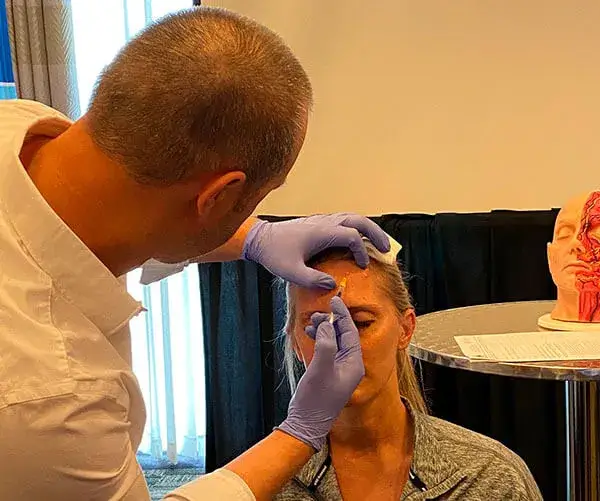Botox® Certification for Nurses
By Dr. Stephen Cosentino
PRESIDENT OF EMPIRE MEDICAL TRAINING
Botox Certification for Nurses: What to Expect
With the important qualifier that this is a general guide only and each Botox certification program’s curriculum is unique, you can expect basic Botox certification programs for nurses to cover the following (with more detail to follow about each item):- Patient screening and assessment
- Botox handling and safety
- Oral and maxillofacial anatomy, musculature, neurophysiology, and vasculature
- General and procedure-specific injection training
- Practice considerations
Patient screening and assessment
Comprehensive Botox certification for nurses should cover these screening and assessment topics:- Procedures for initial patient assessment and consultation
- Guidelines for assessing patient objectives and suitability
- Indications and contraindications for Botox and other botulinum toxin medications and procedures
- Dosing considerations for aesthetic procedures
Botox handling and safety
Botox certification courses should cover the full breadth of handling and safety issues that all practitioners need to know before integrating Botox into their practices:- Proper transportation and storage of Botox and similar medications
- Botox dilution guidelines
- Sterile handling and preparation guidelines
- General risks of Botox injection
- Possible side effects and complications to watch for immediately following treatment
- Patient care: Guidance to give patients for self-monitoring for side effects and complications in the hours and days following treatment
Oral and maxillofacial education
Any basic Botox certification course must include a thorough overview of oral and facial anatomy, musculature, neurophysiology, and vasculature. For each Botox injection site covered, this overview covers muscle location, size, and depth, as well as non-muscular features at each site that play into treatment considerations. More advanced Botox certification courses cover the same ground with regards to other areas of the head, neck, and body, but nurses seeking initial Botox certification usually will not receive detailed training in these areas.Injection training
Accredited Botox certification courses should include hands-on injection training with live volunteers. Each course covers different procedures and techniques, but basic certification generally includes guidance on safe, effective injection for common facial sites such as:- Forehead lines
- Glabellar lines
- Crows’ feet
- Lip lines
- Marionette lines
- Nasal lines
- Condition-specific diagnosis
- Treatment planning, including the number and location of injections
- Determining proper dosing for the patient and procedure
- Proper injection technique
Practice considerations
This subject covers non-medical considerations for nurses certified in Botox. It may include:- Practical tips for integrating Botox administration into an existing nurse-run practice
- Regulatory and licensing considerations for nurses administering Botox
- Patient intake and billing procedures, including which forms to use
- Appropriate pricing for Botox and related procedures
- Securing liability insurance
A Caution About Non-Accredited Botox Certification for Nurses
Nurses should pay close attention to accreditation status when evaluating Botox seminar programs and rule out certification opportunities that aren’t accredited by relevant state medical authorities. Non-accredited opportunities are not guaranteed to meet minimum standards required by state regulation and may result in clinicians operating outside the law, with adverse consequences (including sanction or malpractice claims) as a distinct long-term risk. Beyond the legal and professional risks of non-accredited courses, these courses are not guaranteed to provide quality training. Clinicians that learn how to administer Botox from low-quality, non-accredited programs may receive substandard or incomplete instruction that compromises their standard of care and puts their patients at risk. Nurses seeking to add Botox to their practices should seek courses that offer hands-on instruction by practitioners with years or decades of practice experience, feature live volunteers, and use curriculum created by leading aesthetic professionals.Beyond Basic Botox Certification for Nurses: Advanced Coursework and Electives
For nurse practitioners and registered nurses who wish to make Botox a core practice area, basic Botox certification is just the beginning. Accredited training programs may offer additional opportunities for continuing medical education around Botox and other botulinum toxin medications:Botox Injections Elsewhere on the Head, Neck, and Body
Basic Botox certification courses typically cover common conditions and procedures of the face and do not focus on other areas of the head, neck, or body. Nurses seeking instruction in these areas may need to enroll in one or more followup courses. Such courses may cover the following:- Bruxism (involuntary jaw clenching) and TMJ disorder, although these are sometimes covered in basic Botox certification courses due to their maxillofacial location
- Platysmal bands (“turkey neck”) and other lining issues of the neck
- Botox for chronic migraine treatment, which may involve injections to the back of the head, neck, and shoulders
- Cervical dystonia, a painful condition characterized by involuntary neck movements
- Upper and lower limb spasticity
- Urinary incontinence
- Hyperhidrosis (excessive sweating) in the armpits, hands, and feet
Advanced Botox Injection Techniques
Basic Botox certification courses should provide all the instruction nurses need to safely and effectively inject Botox for common oral and maxillofacial conditions, but they only scratch the surface of injection technique. More advanced courses cover a much wider range of injection practices, including more sophisticated and fine-grained ones not suitable for beginners:- Advanced eyebrow lifting and sculpting techniques
- Advanced lip sculpting techniques
- Techniques for treating deficient dental papillae (“black triangles”)
- Nefertiti lift, an advanced technique for line and wear reduction on the lower face
- Facial volumization techniques


